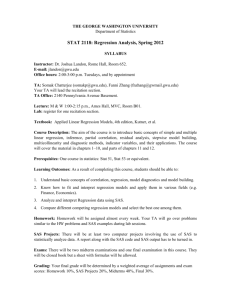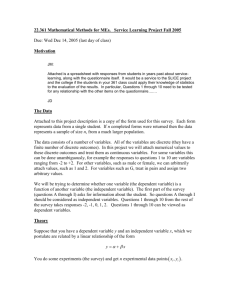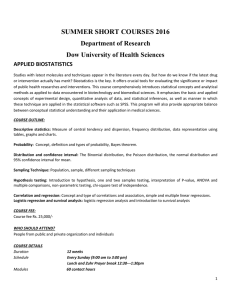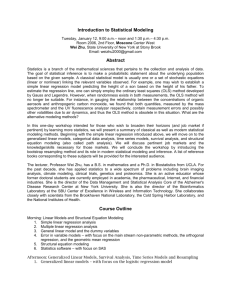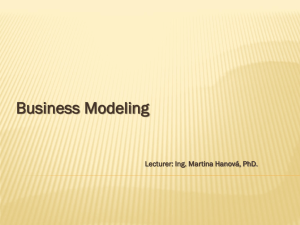Probability and Statistics – Math 324
advertisement
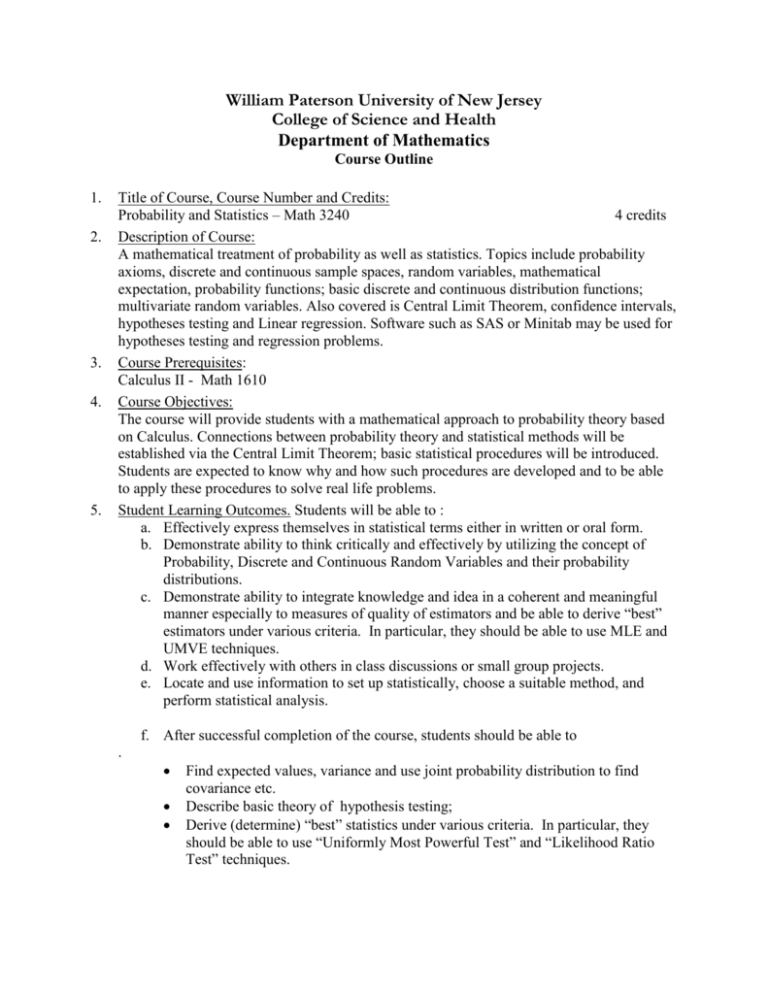
William Paterson University of New Jersey College of Science and Health Department of Mathematics Course Outline 1. 2. 3. 4. 5. Title of Course, Course Number and Credits: Probability and Statistics – Math 3240 4 credits Description of Course: A mathematical treatment of probability as well as statistics. Topics include probability axioms, discrete and continuous sample spaces, random variables, mathematical expectation, probability functions; basic discrete and continuous distribution functions; multivariate random variables. Also covered is Central Limit Theorem, confidence intervals, hypotheses testing and Linear regression. Software such as SAS or Minitab may be used for hypotheses testing and regression problems. Course Prerequisites: Calculus II - Math 1610 Course Objectives: The course will provide students with a mathematical approach to probability theory based on Calculus. Connections between probability theory and statistical methods will be established via the Central Limit Theorem; basic statistical procedures will be introduced. Students are expected to know why and how such procedures are developed and to be able to apply these procedures to solve real life problems. Student Learning Outcomes. Students will be able to : a. Effectively express themselves in statistical terms either in written or oral form. b. Demonstrate ability to think critically and effectively by utilizing the concept of Probability, Discrete and Continuous Random Variables and their probability distributions. c. Demonstrate ability to integrate knowledge and idea in a coherent and meaningful manner especially to measures of quality of estimators and be able to derive “best” estimators under various criteria. In particular, they should be able to use MLE and UMVE techniques. d. Work effectively with others in class discussions or small group projects. e. Locate and use information to set up statistically, choose a suitable method, and perform statistical analysis. f. After successful completion of the course, students should be able to . Find expected values, variance and use joint probability distribution to find covariance etc. Describe basic theory of hypothesis testing; Derive (determine) “best” statistics under various criteria. In particular, they should be able to use “Uniformly Most Powerful Test” and “Likelihood Ratio Test” techniques. Probability and Statistics – Math 3240 6. 7. 8. 9. 10. 11. 12. 13. 14. Topical Outline of the Course Content: 1. Axioms of probability and simple probability rules; Conditional 2.5 weeks probability and the concept of independence. 2. Random variables; Distribution functions; Expected value and 3 weeks variance; Commonly used random variables such as Binomial, Poisson, Uniform, Exponential and Normal random variables. 3. Functions of a random variable; The Central Limit theorem. 2 weeks 4. Estimation: Point estimator; Unbiasness; Error of estimation and 2 weeks confidence interval for the population mean. 5. Hypothesis testing; Controlling type I and II errors; Power of the test; 2 weeks Procedures for testing hypothesis concerning the population mean. 6. Simple linear regression; Correlation coefficient; The least squares line 1 week and its applications. 7. Introduction of using SAS to solve statistical problems; Sample SAS 1 weeks programs for hypothesis testing, Linear Regression, organizing and presenting data. (Optional) Guidelines/Suggestions for Teaching Methods and Student Learning Activities: Lectures, classroom discussions and computer lab work Guidelines/Suggestions for Methods of Student Assessment (Student Learning Outcomes) Through quizzes, tests, and final examination. Regular homework is assigned as well as computer based assignments Suggested Reading, Texts and Objects of Study: Probability and Statistics for Engineering and the Sciences, Jay L. Devore, Duxbury Press. Bibliography of Supportive Texts and Other Materials: 1. Mathematical Statistics with Applications, by Dennis D. Wackerly et al. 5th Edition, Wadsworth Publication Company. 2. Applied Statistics and SAS Programming Language, by Cody and Smith, 3rd Edition, Prentice-Hall Inc. Preparer’s Name and Date: Prof. Z. Chen, Fall 1997 Original Department Approval Date: Fall 1997 Reviser’s Name and Date: Wooi K. Lim, Mandeleine Rosar, Donna Cedio-Fengya—Spring 2005 Prof. S. Maheshwari – Fall 2001. Prof. Z. Chen – Spring 2000 Departmental Revision Approval Date: Spring 2000 Page 2 of 2


